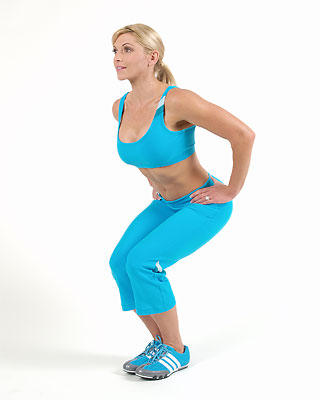
July 19, 2009
Squats bad for your knees?
Think squats are bad for your knees? Think again!
Fact: Studies have repeatedly shown the squat to be a safe, effective exercise; when performed properly, it poses little risk to those who have healthy patellar function. Even elite athletes who squat several times their bodyweight have few reported injuries directly attributable to the activity.

Squatting actually places less stress on the knee joint than leg extensions. This has to do with the way that force is applied during exercise performance. In the leg extension, loading is applied perpendicular to the long axis of the tibia—a fact that creates tremendous shear force in the patellar region. Alternatively, loading during the squat involves a high amount of compression (i.e. a “squeezing” force), with forces applied parallel to the long axis of the tibia. Since a joint is better able to withstand forces from compression as opposed to shear, it therefore follows that squats are more joint-friendly than leg extensions.
What’s more, leg extensions tend to overstress the anterior cruciate ligament (ACL). During performance, the quadriceps reacts by pulling the tibia forward (a phenomenon called tibial translation). The ACL in turn opposes the quadriceps by trying to prevent translation of the tibia. These two antithetic actions place a considerable amount of stress on the ACL, and can potentially injure the ligament (and other soft tissue structures, as well).
Squats, on the other hand, have somewhat of a protective effect on the knee ligaments. Due to the multi-joint nature of the squatting movement (both the hip and knee are involved in performance), the hamstrings are activated as co-contractors and exert a counter-regulatory effect on the pull of the quadriceps. The co-contraction of the hamstrings and quads help to neutralize tibial translation, alleviating stress on the ACL.
All things considered, squats shouldn’t be avoided by those with healthy knees. They are a terrific exercise that works not only the lower body, but a significant portion of the torso, as well. It’s estimated that squat performance involves the recruitment of over 200 muscles in total, including the assistance of many stabilizer muscles. Without the active participation of these stabilizers, the act of squatting simply cannot take place. Hence, while the glutes and thighs are the prime muscle movers, synergistic muscle action is derived from the abdominals, spinal erectors, rhomboids, trapezius and other muscles. Squats therefore have a systemic effect on anabolism, helping to promote overall muscular development.
Further, the squat is an extremely functional exercise. It is used in many activities of daily living. Any time you lift an object from the floor (or sit in a chair, for that matter!), squatting is involved in the movement. Consequently, squats can help build the kind of practical strength and kinesthetic awareness that facilitates better performance of everyday tasks. In many cases it can even help to prevent lifting-related injuries at home and in the workplace.
Now this is not to say that squats are appropriate for everyone (in actuality, there is NO one exercise that is appropriate for everyone!). Conditions such as degenerative arthritis and various connective tissue disorders can be contraindications for squatting movements. But it’s not the squat, per se, that is harmful here: any form of loaded (or even unloaded) knee flexion and extension can exacerbate a patellar-related injury. Hence, it you have pre-existing knee pathology, caution must be utilized in both the choice and execution of thigh exercises. But provided no contraindications exist, you should have no problem squatting on a regular basis. It’s one of the best exercises you can do for both your body and your health!
Stay Fit!
Brad
No Comments
No comments yet.
RSS feed for comments on this post.
Sorry, the comment form is closed at this time.





 Entries (RSS)
Entries (RSS)



